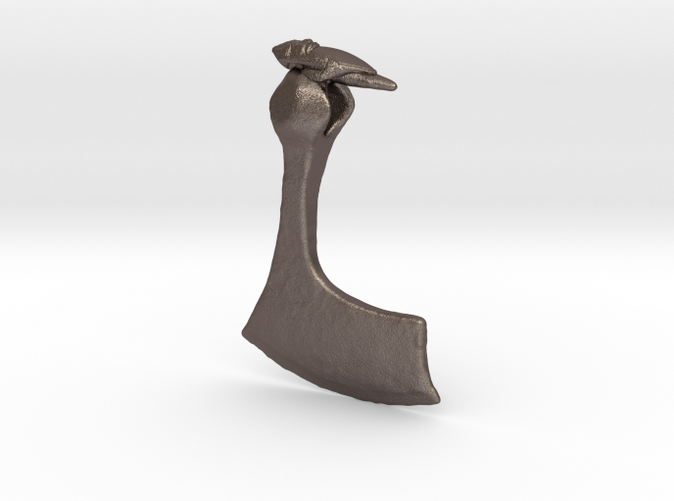-
-
Search our Marketplace
-
- Software
- Manufacturing
- Industries
-
Materials
Not sure what material to choose? View 3D Materials Guide
- ABOUT Marketplace
- Get a Quote
- Sign In
-
0You haven't added any 3D printed products yet.
The Berserker Bearded Axe Pendant:
An interpretive piece based off the great Dane axes of the 10th-11th centuries in areas outside Scandinavia where Viking influence was strong, such as England, Ireland and Normandy. Historical accounts depict the Dane axe as the weapon of the warrior elite in this period. The 12th century Lewis Berserker chessmen adorns the axe and pays homage to the berserkers or Úlfhéðnar. The berserkers were Norse warriors who are primarily reported in the Old Norse literature to have fought in a nearly uncontrollable, trance-like states. The Úlfhéðnar, sometimes described as Odin's special warriors: "went without their mailcoats and were mad as hounds or wolves, bit their shields... they slew men, but neither fire nor iron had effect upon them”.
I'll ask of the berserks, you tasters of blood,
Those intrepid heroes, how are they treated,
Those who wade out into battle?
Wolf-skinned they are called. In battle
They bear bloody shields.
Red with blood are their spears when they come to fight.
They form a closed group.
The prince in his wisdom puts trust in such men
Who hack through enemy shields
King Harald Fairhair's use of berserkers as "shock troops" broadened his sphere of influence. Other Scandinavian kings used berserkers as part of their army of hired men and sometimes ranked them as equivalent to a royal bodyguard. It may be that some of those warriors only adopted the organization or rituals of berserk männerbünde, or used the name as a deterrent or claim of their ferocity.
Emphasis has been placed on the frenzied nature of the berserkers, hence the modern sense of the word "berserk". However, the sources describe several other characteristics that have been ignored or neglected by modern commentators. Snorri's assertion that "neither fire nor iron told upon them" is reiterated time after time. The sources frequently state that neither edged weapons nor fire affected the berserks, although they were not immune to clubs or other blunt instruments.
Similarly, Hrolf Kraki's champions refuse to retreat "from fire or iron". Another frequent motif refers to berserkers blunting their enemy's blades with spells or a glance from their evil eyes. This appears as early as Beowulf where it is a characteristic attributed to Grendel. Both the fire eating and the immunity to edged weapons are reminiscent of tricks popularly ascribed to fakirs.
In 1015, Jarl Eiríkr Hákonarson of Norway outlawed berserkers. Grágás, the medieval Icelandic law code, sentenced berserker warriors to outlawry. By the 12th century, organised berserker war-bands had disappeared.
The Lewis Chessmen, found on the Isle of Lewis (Outer Hebrides, Scotland) but thought to be of Norse manufacture, include berserkers depicted biting their shields.
References: Wikipedia
Grundy, Stephan (1998). Shapeshifting and Berserkgang. Evanston: IL: Northwestern University Press. p. 18.
Page, R. I. (1995). Chronicles of the Vikings. Toronto, Canada: University of Toronto Press. p. 109. ISBN 978-0-8020-7165-1.
Snorri, Sturluson (1976). Egil's Saga. Harmondsworth: Penguin. p. 66.
Elton, Oliver (1905) The Nine Books of the Danish History of Saxo Grammaticus. New York: Norroena Society.
